|
Short History of the Nintendo Gameboy
-
1980: Gunpei Yokoi creates the first Nintendo handheld
system, the 'Game & Watch'.
-
1989: Nintendo Gameboy released in Japan.
-
1994: Super Gameboy released, allowing you to play
Gameboy titles on your TV via your SNES.
-
1995: Play it Loud! Multicoloured Gameboy systems
released.
-
1996: Gameboy Pocket released.
-
1997: Gunpei Yokoi is tragically killed in an auto
accident at the age of 56. Gameboy Color released.
-
1998: Pokemon revealed. Gameboy fever grips the world.
-
2000: 100 millionth Gameboy system sold, by the end of
the year 110 million Gameboy units would be in circulation.
-
2001: Gameboy Advance released on November 11th, 2001
-
2003: Gameboy Advance SP released, 14 February 2003.
Detailed History of the Nintendo
Gameboy
Gameboy (1989): Nintendo of Japan releases their
small but revolutionary device called the "Gameboy".
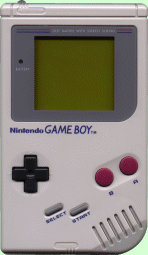
The Nintendo Gameboy was developed and invented by
Gunpei Yokoi.

Success for the Gameboy arrived along with the game
Tetris, which was developed by two Russians, Alexey Pajitnov and Dimitry
Pavlovsky.

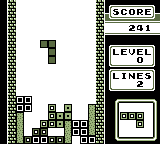
When Tetris was released, the Gameboy popularity was
exceptional with more than 60 million copies sold worldwide.
Original Nintendo Gameboy
Specification:
-
CPU modified Z80 @ 4.194304MHz
-
RAM 8K internal (+8K Video)
-
AUDIO 4 channel stereo
-
VIDEO 160 x 144 LCD - 4 shade greyscale
-
STORAGE Cartridge slot
-
Screen : 2.6" dot matrix LCD
-
Colour Depth : 4 shades of grey
-
Size : Width 90mm, Depth 32mm, Height 148mm
-
Power : 4 AA batteries, 35 hour battery life
-
MISC: Serial port for multiplayer games
My memories of
the original Gameboy.
The original Gameboy was huge. Whilst it was still
portable, it didn’t exact slide in to the palm of your hand!
Secondly, the screen seemed to be made in such a way that
it was be impossible to see. This took away from the portability of the Gameboy
severely, because you could pretty much only play it under florescent lights or
dim sunlight
Most original Gameboys were a basic grey colour, but in
1995 they did bring out some variants including red.

Gameboy Pocket (1996): After 7 years, Nintendo
decides to make the massive development leap of releasing a smaller and more
compact Gameboy, the “Pocket Gameboy” or “Gameboy Pocket”.
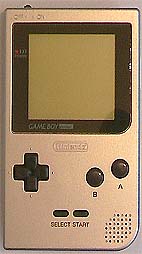
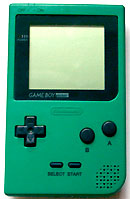
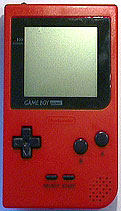
They managed to eliminate that "green
screen" effect that the original Gameboy suffered from. The Gameboy Pocket
was produced in various colours and with a huge library of more than 1000 titles
the Gameboy Pocket was a big success.
Gameboy Colour (1998): Having produced the Gameboy
Pocket in a multitude of coloured cases. Nintendo decided to go one better and
to produce a Gameboy with a colour screen.
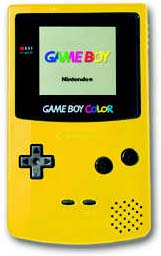
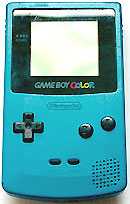
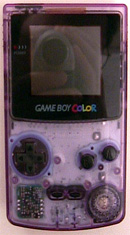
Featuring up to 56 simultaneous colours, the “Gameboy
Color” becomes one of the most popular handheld gadgets on the market. With
the highly popular game Pokemon being released the sales top the 100 million
Gameboy's sold worldwide!
Gameboy Color Specifications
-
CPU: 4/8-bit Sharp Z80 work-alike at 8 MHz, 2 modes:
Single (4 MHz) and Double (8 MHz)
-
RAM: 32 Kb
-
Cartridge RAM: 128 Kb
-
ROM: 64-MBit max
-
VRAM: 16 Kb
-
Sound: 4 Channels FM stereo, single mono speakers,
Stereo headphones jack
-
Video: Display 160x144 pixels, highly reflective,
Thin-Film Transistor (TFT) colour liquid crystal display made by Sharp
-
Colour Palette: 32,768 colours; Supports 10,32, or 56
simultaneous colours on-screen
-
Sprites: 40 sprites of either 8 x 8 or 8 x 16
(changeable); 10 Sprites per line; Sprites are 4 colours with one always
transparent (3 diff colours max on 1 sprite); larger sprites possible.
-
Tiles: 512 on screen
-
Serial: 512 Kbps; up to 4-up at a time
-
Power: 2 AA batteries provide 30+ hours, AC Adapter (DC
3V),
-
Indicator LED
-
Input: 8 way D-Pad, 4 buttons, volume dial, power
switch, Serial I/O, Infrared I/O, Cart I/O
-
IR: Less than 2 metres at 45 degrees
-
Size: Slightly larger than Game Boy Pocket
Gameboy Advance (2001): The biggest leap in the
history of the Gameboy occurred with the release of the Gameboy Advance


By adding two sidebar buttons L and R, the Gameboy Advance
gave the developers more opportunity to make games that were more advanced and
complicated.
The major downfall of the Gameboy Advance was the lack of
back light. Twelve years since the original Gameboy was produced and you still
had to play it under a separate light. Weird looking add-ons were produced to
illuminate the screen. The best one was the Afterburner kit. This involved
having to open the case and invalidating the warranty, but was a very good
improvement over the standard Gameboy Advance.
Gameboy Advance
Specifications
-
CPU: 16 MHz 32-bit RISC-CPU + 8-bit CISC-CPU
-
Memory: 32KB WRAM + 96KB VRAM + 256KB WRAM
-
Screen: Reflective TFT Colour LCD
-
Screen Size: 40.8 mm x 61.2 mm
-
Resolution: 240 x 160 pixels
-
Display Ability: 32 000 colours
-
Sound: Mono speakers, stereo headphones
-
Multiplayer Options: Up to four GBAs, up to two GB/GBCs
-
Power: Two AA batteries, or battery pack
-
Battery life: 15 hours for batteries, 10 hours for
battery pack
-
Dimensions:
82 mm x 144.5 mm x 24.5 mm
Gameboy
Advance SP (February of 2003): Finally, the new Gameboy Advance SP
(GBA) with front lit screen and a more compact folding design was released.

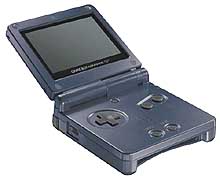
Gameboy Advance
SP Specifications:
-
CPU: 32-Bit ARM with embedded memory
-
MEMORY: 32 Kbyte + 96 Kbyte VRAM (in CPU), 256 Kbyte
WRAM (external of CPU)
-
SCREEN: 2.41" x 1.61" (61 x 41 mm) reflective
TFT colour LCD
-
RESOLUTION: 240 x 160 pixels
-
COLOUR: Can display 511 simultaneous colours in
character mode and 32,768 simultaneous colours in bitmap mode
-
SOFTWARE: Fully compatible with Game Boy and Game Boy
Color Game Packs
-
LIGHT SOURCE: Front light integrated with LCD
-
SIZE (closed): Approximately 3.3" height x
3.23" width x 0.96" depth (84 x 82 x 24 mm)
-
WEIGHT: Approximately 5 ounces (140 gm)
-
POWER: Rechargeable lithium-ion battery
-
BATTERY LIFE: 10 hours continuous play with light on 18
hours with light off 3 hours recharging.
Accessories
available for the Gameboy Advance SP.
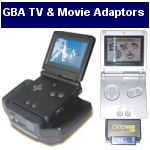 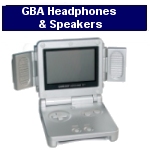 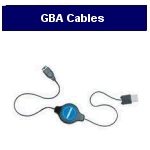 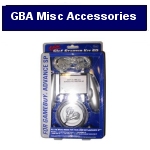
Gameboy Advance movie & mp3 player adaptor
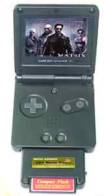
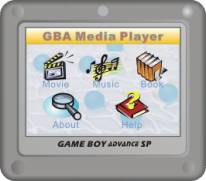
The GBA Movie Player adaptor enables you to use your
Gameboy Advance™ or Gameboy Advance SP™ to play video and audio files and
read e-books from standard Compact Flash™ cards.
You can use your PC and your normal Compact Flash card
reader to transfer and convert your media files to your Compact Flash cards.
Gameboy Advance & SP TV Tuner
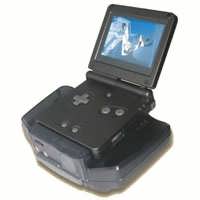
This Gameboy Advance & SP TV Tuner add-on turns it into
a Portable TV tuner / Colour Monitor.
The Gameboy Advance SP TV Tuner lets you to watch your
favourite TV shows on the handheld. The Gameboy Advance SP tuner can also be
connected to existing DVD players, other video game systems or any video/audio
source via the A/V port. Both GBA & GBA SP compatible.
|